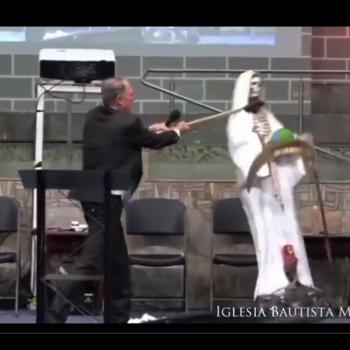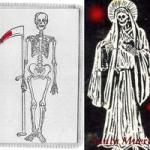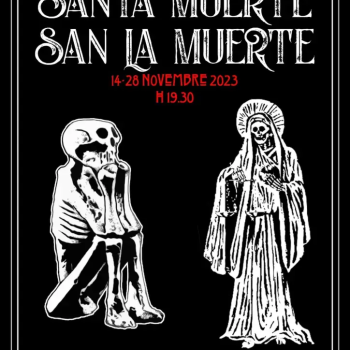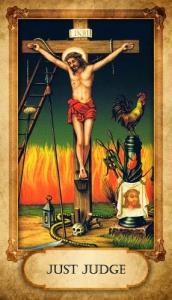
Dr. Andrew Chesnut writes in his book Devoted to Death:
“If the association between Santa Muerte and matters of judgment and law is strong, it is probably even stronger for her Argentine male counterpart, San La Muerte. Indeed, one of the two main myths about the origins of the Argentine skeleton saint refers directly to justice. […] And that is why one of the nicknames of San La Muerte is San Justo (Saint Justus) – San Giusto.”
I begin from this context to speak about a martyred saint of the Catholic tradition of my country, Italy. Precisely in the city of Trieste, located in the northeast of the peninsula in the Friuli-Venezia-Giulia region, a special cult is reserved for Saint Justus, a young Christian who suffered martyrdom in the third century AD.
The name Giusto derives from Iustus, a widespread Latin cognomen. It originates from the Latin word iustus, which means “just”, “honest” and from which the term Justice (iustitia: equity, clemency, law, precept, righteousness, holiness) derives.
The hagiography of Saint Justus, patron saint of Trieste, does not differ much from those of other holy martyrs contemporaneous with him. He was born and lived in Trieste in the third century AD. The various codes that report the Passio sancti Iusti martyris, medieval manuscript sources collected in the critical edition by Stefano Di Brazzano, tell the story of a boy who, burning with love for Jesus, devoted himself with zeal to works of Christian charity. He had the misfortune of being born under the reign of the emperors Maximian and Diocletian, who obliged all subjects to offer sacrifices to the pagan gods. Anyone who refused would face the death penalty.
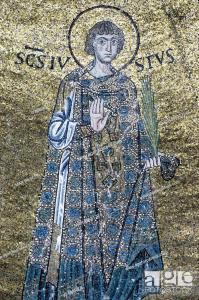
Thus it was that Justus was forced to appear before the magistrate Manazio to undergo an interrogation. On that occasion the young man publicly declared his Christian faith. Without being intimidated by the death threats, he refused to sacrifice to the gods and repeatedly expressed his desire to undergo martyrdom in order to finally enjoy the beatitudes of Heaven.
The boy was taken to prison and subjected to torture, but his torturers did not bend his will at all. Furious, the magistrate Manazio ordered that Justus be sentenced to an ignominious death – lead weights would be tied around his neck, hands and feet and he would be thrown to the bottom of the sea. The young man stoically accepted the verdict, and with great joy went to embrace the glorious Death.
They forced him to get into a small boat and took him off the coast. Justus never stopped singing hymns to the Lord. Having said his last prayer, his tormentors threw him into the sea. And as soon as he descended into the murky depths, the ropes with the weights snapped, and the sea returned his body intact to the shores of the city of Trieste.
The next day a priest named Sebastiano went to the beach to retrieve the mortal remains of the young martyr, as the spirit of Justus that same night had visited him in a dream, asking him to do this to offer him a worthy burial. Sebastiano and his brothers in faith collected the body of Blessed Justus, anointed it with essences and wrapped it in precious linen sheets, and then buried him not far from the shore where they had found him.
In the Gregorian calendar all Catholic saints are celebrated on the date of their death or, in the case of the Holy Martyrs, on the day when they courageously offered their life and blood as an act of extreme sacrifice in the name of God’s love. In most cases, however, the hagiographic sources do not give us the exact dates on which, according to the legends, these glorious saints achieved eternal bliss in face of the most atrocious torments. The dates of their commemoration are therefore uncertain. The hagiography of Saint Justus is one of the rare cases in which the precise date of martyrdom is indicated at the end of the Passio:
“Passus est autem beatissimus Iustus sub die quarto nonas Nouembris”.
“The most blessed Justus suffered the fourth day before the month of November”.
It seems therefore that Saint Justus faced martyrdom on November 2, 303 AD (according to the Roman calendar). A strange coincidence, recalling that November 2s universally recognized as the Day of the Dead and All Souls Day. This situation, in fact, made the celebration of the rituals dedicated to the saint in the city of Trieste, of which he is the patron saint, rather problematic. The people of Trieste therefore chose to move the celebrations in honor of Saint Justus to November 3, the day of his burial in the plot of land where the basilica dedicated to him currently stands.
It is also curious that the Argentine folk saint of death, San La Muerte, is also known by the same name as a Christian saint, whose commemoration date corresponds to the Day of the Dead. Of course this could be a coincidence, but it is certainly very peculiar. San La Muerte, who is also known as Saint Justus and the Just Judge, is often invoked by devotees with legal problems. Through his intercession, San La Muerte assures devotees of victory in the courtroom. It is for this reason that, in popular tradition, the Argentine Skeleton Saint shares the same moniker as the advocation of Christ, the Just Judge.
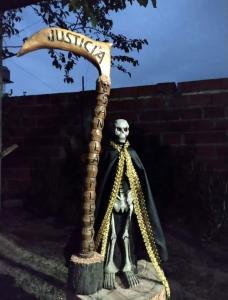
(Photo courtesy of Dr. Alejandro Frigerio)
In the portrayal of Christ, the Just Judge the Cross stands out against a cloudless sky, illuminated by a large solar disc; shooting flames arise from the arid ground which, from behind, seem to surround the Cross. The suffering Christ is surrounded by various objects and animals with specific symbols. A skull is even visible at the foot of the cross. The prayer to Jesus the Just Judge was written around 1500. Approved by the Inquisition, it was issued by Pope Leo XI. This prayer begs for protection against enemies and begs for the grace of a “good death” in the name of the Holy Blood shed for the remission of sins.
Il testo originale italiano…
Il Dr. Andrew Chesnut scrive nel suo libro Santa Muerte. I sette volti della mietitrice:
“Se è forte l’associazione tra la Santa Muerte e le questioni di giudizio e legge, è probabilmente ancora più forte per la sua controparte maschile argentina, San La Muerte. Infatti, uno dei due principali miti sulle origini del santo scheletro argentino si riferisce direttamente alla giustizia. […] Ed è per questo che uno dei nomignoli di San La Muerte è San Justo – San Giusto.”
Parto da questo pretesto per parlare di un Santo martire della tradizione cristiano cattolica del mio paese, l’Italia. Precisamente nella città di Trieste, situata a nord-est della penisola nella regione del Friuli-Venezia-Giulia, è riservato un culto speciale a San Giusto, un giovane cristiano che subì il supplizio nel III secolo d.C.
Il nome Giusto deriva da Iustus, un diffuso cognomen romano. Trae origine dalla parola latina iustus, che vuol dire “giusto”, “onesto” e da cui deriva direttamente il termine Giustizia (iustitia: equità, clemenza, legge, precetto, rettitudine, santità).
L’agiografia di San Giusto patrono di Trieste non si discosta molto da quelle dei Santi martiri a lui più o meno contemporanei.
Egli nacque e visse a Trieste nel III secolo d.C. I diversi codici che riportano la Passio sancti Iusti martyris, fonti manoscritte medievali raccolte nell’edizione critica di Stefano Di Brazzano, raccontano la storia di un ragazzo che, bruciando di amore per Gesù, si dedicava con zelo alle opere di carità cristiana. La sua unica sfortuna? Quella di essere nato sotto l’egida degli imperatori Massimiano e Diocleziano, i quali obbligavano tutti i sudditi ad offrire sacrifici agli dèi pagani. Chi si fosse rifiutato, sarebbe andato incontro alla pena di morte.
Fu così che Giusto venne costretto a presentarsi dinanzi al magistrato Manazio per subire un interrogatorio. In quell’occasione il giovane dichiarò pubblicamente la propria fede cristiana. Senza farsi intimorire dalle minacce di morte rifiutò di sacrificare agli Dèi ed espresse più volte la sua volontà di subìre il martirio per poter finalmente godere delle beatitudini del Paradiso.
Il ragazzo venne condotto in prigione e venne sottoposto a tortura, ma il supplizio non piegò affatto la sua volontà. Furente, il magistrato Manazio ordinò che Giusto fosse condannato a una morte ignominiosa: gli sarebbero stati legati al collo, alle mani e ai piedi dei pesi di piombo e sarebbe stato gettato in fondo al mare. Il giovane accolse stoicamente il verdetto, e con grande gioia si diresse ad abbracciare la Morte gloriosa. Lo costrinsero a salire su una piccola barca e lo portarono al largo della costa. Giusto non smise mai di cantare inni al Signore. Recitata l’ultima preghiera, i suoi aguzzini lo gettarono in mare. E non appena discese negli abissi marini, le funi con i piombi si ruppero, e il mare restituì il suo corpo intatto alle rive della città di Trieste. L’indomani un sacerdote di nome Sebastiano si recò in spiaggia per recuperare le spoglie mortali del giovane martire, poichè proprio lo spirito di Giusto quella stessa notte lo aveva visitato in sogno, chiedendogli di fare ciò per offrirgli una degna sepoltura. Sebastiano e suoi confratelli ricomposero il corpo del beato Giusto, lo unsero di aromi e lo avvolsero in preziosi teli di lino, per poi seppellirlo non distante dalla riva in cui lo avevano trovato.
Nel calendario gregoriano tutti i Santi cristiani vengono celebrati nella data della loro morte o, nel caso dei Santi Martiri, nel giorno in cui con coraggio offrirono la loro vita e il loro sangue come atto di estremo sacrificio nel nome dell’amore di Dio e di Gesù Cristo suo figlio. Nella maggior parte dei casi, però, le fonti agiografiche non ci riportano con esattezza le date in cui, secondo le leggende, questi gloriosi Santi raggiunsero la beatitudine eterna affrontando i più atroci tormenti. Le date della loro commemorazione sono quindi aleatorie. L’agiografia di San Giusto, invece, è uno dei rari casi in cui la data precisa del martirio è messa in evidenza al termine della Passio:
“Passus est autem beatissimus Iustus sub die quarto nonas Nouembris”.
“Il beatissimo Giusto patì il quarto giorno prima delle none di Novembre”.
Pare quindi che San Giusto abbia affrontato il martirio il 2 Novembre 303 d.C (considerando il calendario romano). Una strana coincidenza, sapendo che il 2 Novembre è universalmente riconosciuto come Giorno della commemorazione dei Defunti. Questa situazione, in effetti, ha reso piuttosto problematica la celebrazione dei rituali dedicati al Santo nella città di Trieste, del quale è patrono. I triestini hanno quindi scelto di spostare per questioni pratiche i festeggiamenti in onore di San Giusto al 3 Novembre, giorno del suo seppellimento nella striscia di terra dove attualmente sorge la basilica a lui dedicata.
E’ altresì curioso il fatto che San La Muerte sia anche conosciuto con il medesimo nome di un Santo cristiano, la cui data di commemorazione corrisponde al Giorno dei Morti. Naturalmente potrebbe trattarsi di una coincidenza, ma è certamente molto particolare.
San La Muerte, in qualità di San Justo, è spesso invocato quando ci si trova ad affrontare tribolazioni di tipo legale. Tramite la sua intercessione, San La Muerte assicura al devoto il buon esito di una vertenza giuridica. E’ per questo che, nella tradizione popolare, si preferisce accostare lo Scheletro santificato a Gesù “Justo Juez” (Giusto Giudice), una particolare raffigurazione del Cristo crocifisso. La Croce si staglia contro un cielo limpido e terso, illuminato da un grande disco solare; alte fiamme nascono dal terreno arido che, da dietro, sembrano fare da contorno alla Croce. Gesù sofferente è attorniato da vari oggetti e animali con specifiche simbologie. Ai piedi della croce è visibile persino un teschio. La preghiera a Gesù Giusto Giudice venne scritta intorno al 1500. Approvata dall’Inquisizione, venne diffusa da Papa Leone XI. Questa preghiera implora protezione contro i nemici e supplica la grazia di una “buona morte” in nome del Sacro Sangue versato in remissione dei peccati.









